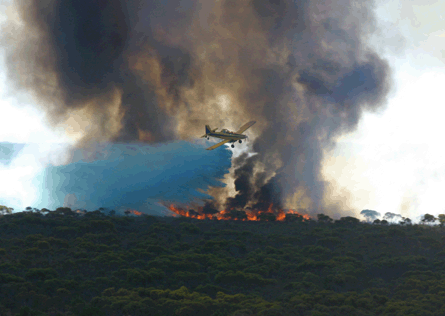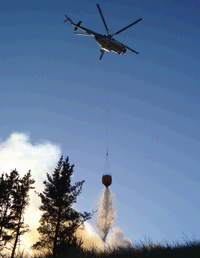Australia's 2009-10 fire season has begun, with the ever-present threat of bushfires in Queensland in late August and continuing through to late April on the other side of the country in Western Australia. The signs do not look good after a dry winter in many parts of the country.
But Australian authorities know a thing or two about battling bushfires and considerable research has been conducted into developing the most effective firefighting approach, including aerial operations.
The effectiveness of aerial firefighting has been one area of research for the Bushfire Cooperative Research Centre (CRC), which was established under the government's CRC programme to better understand the social, economic and environmental aspects of bushfires. It comprises more than 30 partners, including fire and land management agencies, universities and government agencies.
 |
|---|
© South Australian Department of Environment |
After collecting data from 284 fires that used aerial suppression, the centre's June 2007 report, The Effectiveness and Efficiency of Aerial Firefighting in Australia, concluded that factors influencing the effectiveness of aerial firefighting include fire intensity, fuel characteristics, fire perimeter, aircraft specification and productivity. Aircraft offer three major advantages over ground suppression resources, says the report - speed, access and observation.
RAPID ATTACK
The most effective use of aircraft is rapid attack on fires in their incipient stages, improving the probability of first attack success by 50% or more, it concludes. But for an aircraft to provide effective assistance it must be available on call, rapidly dispatched with minimal travel time and with logistical systems in place.
The report also concluded that large fixed-wing air tankers, such as the McDonnell Douglas DC-10, are at a cost disadvantage, particularly in first attack when fires are small and where water-drop accuracy is required.
Australia uses type one heavy helicopters, such as the Bell 214B, Erickson S64F, Mil-8 and Sikorsky S-61, with a capacity to carry up to 2,650 litres (700USgal) of fire suppressant; type two medium helicopters, such as the Bell 204/205/212 and Kawasaki Bk117, with a capacity of 1,135-2,649 litres; type three light helicopters, with a 380-1,134 litre capacity, including the Bell 206, Eurocopter AS350 and Hughes 500; and single-engined fixed-wing firebombers, such as the Air Tractor 802 and PZL Dromader.
Large multi-engine fixed-wing fire bombers, such as the Lockheed Martin C-130, Douglas DC-6, Fokker F27 and amphibious aircraft have been subject to trials in Australia with limited success, says the report.
A follow-up study on the cost-effectiveness of aerial firefighting in Australia, released earlier this year, concluded that the use of ground resources with initial aerial support is the most economically efficient approach to fire suppression. Crucial factors are speed of deployment and turnaround time, with aircraft preventing more damage than they cost to operate, according to the report.
The study analysed the economic efficiency of different helicopters and fixed-wing types. Overall, high-volume helicopters and fixed-wing aircraft are more efficient, compared with small helicopters and large air tankers, the report says. The Bushfire CRC's research has also included aerial suppression field experiments, measuring suppression effectiveness on operational wildfires, including the Project Fuse (Fire Experiments in Scrub) tests last year.
Following devastating bushfires between 2000 and 2003, the federal, state and territory governments adopted a national approach to aerial firefighting, establishing the National Aerial Firefighting Centre (NAFC). The organisation arranges a national fleet of aircraft, to perform firebombing and air attack supervision roles, which are shared among the states and territories, with individual states and territories supplementing the national fleet with their own aerial resources.
The NAFC receives funding from the federal government that is matched by the states and territories. In the last federal budget the organisation was allocated A$14 million ($11 million) a year over four years.
The arrangement works well, says NAFC general manager Richard Alder. "It's a successful model. Firefighting aircraft are expensive, specialised and relatively scarce resources so it's logical to pool resources, giving us an ability to share and collaborate," he says.
In the 2007-8 fire season alone the national fleet was called out to fires on more than 500 occasions, making more than 7,100 firebombing drops and using more than 12 million litres of suppressant.
Last year the NAFC organised the lease and deployment of almost 40 firefighting aircraft, including AS350B3s, Air Tractor AT502s, AT602s and AT802s, Bell 205, 206s, 212s and 214s, BK117s, Cessna 337s, S-61Ns and S64 Aircranes. A similar core fleet of at least 39 aircraft is lined up for this year.
"Having the mix of aircraft and helicopters we have is optimal," says Alder. "There is likely to ultimately be more than that [39 aircraft], but the final make-up will depend on seasonal considerations and funding, and that won't be locked down for a little while yet," he says, with the fleet ramping up as the season develops throughout the country.
 |
|---|
© Heli HarvestThe Mi-8 has fought fires in Victoria for the past four seasons |
Additional federal funding for more aircraft and helicopters, including a Mil Mi-8MTV-1 on lease from New Zealand-based Heli Harvest, was provided in the last fire season in February to fight the Black Saturday fires that affected Victoria and resulted in the loss of 170 lives and more than 3,500 buildings.
The Mi-8MTV-1 is fitted with long-range fuel tanks and a 5,000 litre Bambi Bucket firefighting system with power-fill capability and a foam injection system. The Mi-8 has fought fires in Victoria for the last four fire seasons.
The Black Saturday fires - the worse in the country's history - followed extreme bushfire weather conditions, with temperatures around 45°C (113°F), low humidity and winds of more than 54kt (100km/h).
More than 50 aircraft were made available to fight the fires - 25 helicopters, 12 single-engined firebombers and 18 reconnaissance aircraft, up from Victoria's normal standby fleet of 34 aircraft. Between 7 and 24 February the fleet flew 3,000h, says Bryan Rees of Victoria's State Aircraft Unit. There is no change to the state's aerial firefighting strategy this year, says Rees, with no additional government funding for extra aircraft. "The strategy worked pretty well," he says, adding that in a "normal" fire season the basic fleet is adequate.
Throughout the country the outlook for this year's fire season is poor, following another dry winter and an El Nino weather pattern.
There is unlikely to be any changes to the current aerial firefighting strategy as a result of the Black Saturday fires, says Alder, with the NAFC recommending to the ongoing Royal Commission investigating the disaster, that the current aerial firefighting policy continues. "The aircraft worked as well as they could in those conditions. It validated the aircraft types and the way we operate them," he says.
The NAFC is, however, investigating alternative capabilities that could improve aerial firefighting. Early last year the organisation released the Future Aerial Fire Management Capability request for proposals. This sought proposals on effective aerial capabilities that are not used in firefighting or fire management in Australia, with the stipulation that the capability must be available within three years.
The RFP asked for information on new methods in aerial fire suppression, including fire-bombing capabilities; fire management techniques; methods of obtaining data, information and intelligence; and control, command and communications. In particular, the NAFC was interested in gathering information on the use of alternative aircraft; unmanned air vehicles for intelligence gathering and communications; and airborne remote sensing.
The NAFC received "an interesting range of proposals" covering "a wide spectrum of capabilities", says Alder. In excess of 30 responses were received, with proposals sorted into three main categories - unmanned aerial systems; large fixed-wing air tankers, including very large tankers; and specific proposals covering alternative suppressants, for example.
The NAFC is evaluating the proposals, gathering more information and working with specific companies to build a case for deployment. "None are at the stage where we are prepared to go ahead with a ready solution. All require development and further work," says Alder, adding that the organisation does not have funding to deploy any of the capabilities.
The NAFC is closely watching what the UAS market can offer, primarily in surveillance and intelligence gathering roles. "I have little doubt we will see unmanned systems operating in aerial firefighting in the next decade, especially in intelligence gathering roles," he says. "But we need to find the niche as the costs associated with UAS still don't give them the edge on conventional methods," he adds.
TANKER OPTIONS
In the area of large air tankers, the NAFC is "looking at some options in more detail, including scenario modelling", says Alder, declining to be specific as the centre guaranteed not to publicise companies or proposal details as part of the RFP process. The evaluations are likely to include, however, the Boeing 747 Supertanker and the DC-10.
The NAFC is in discussions with a number of companies, with trials and demonstrations one possible scenario being discussed, he confirms, although there are no current plans to demonstrate a large air tanker in Australia. "The evaluation process goes on," he says.
Source: Flight International























